A Trip Report, by Stefan & Bryon – Tofino – Hot Springs Cove – Tofino
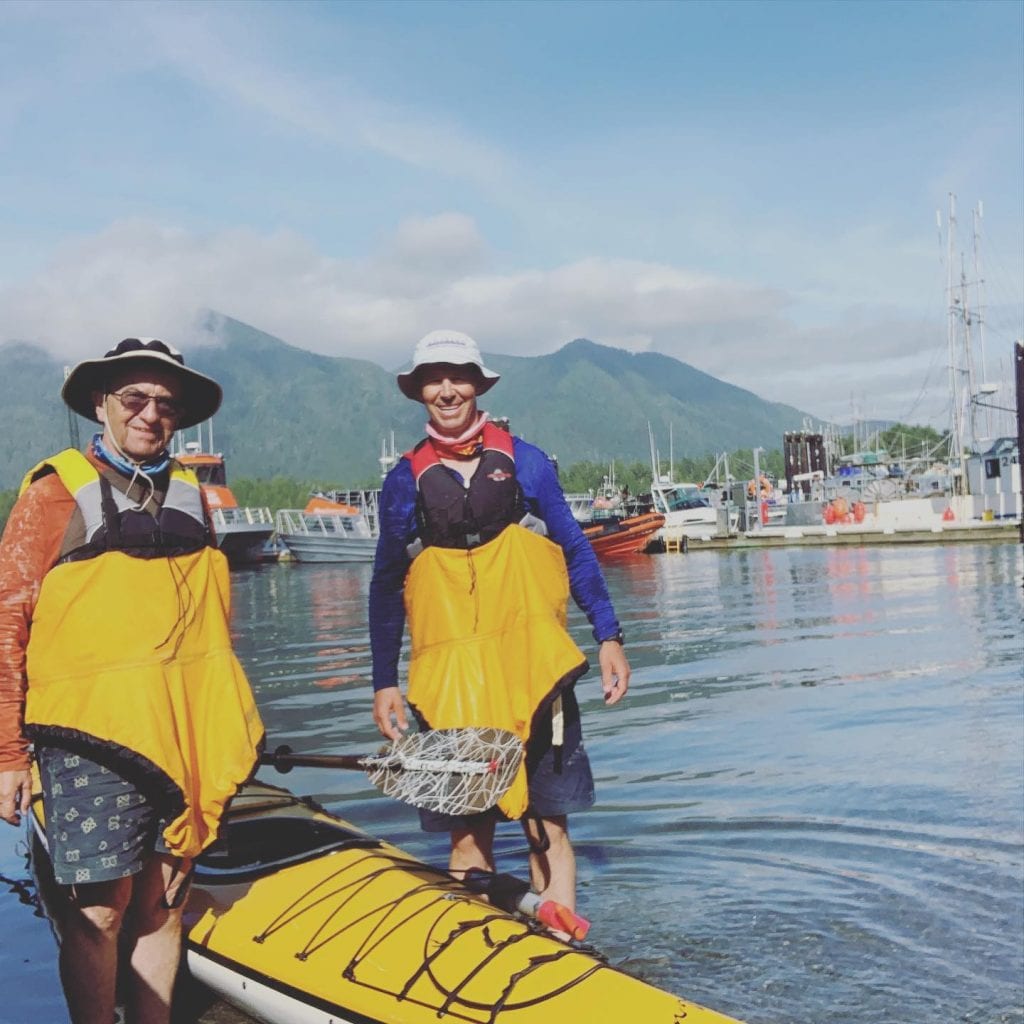
A long long long time ago, my girl friend (now wife) were in Tofino training to be sea kayaking guides. I heard about Hot Springs Cove, and how some people kayak there. Recently, as a mid 50’s guy I have become increasingly concerned about aging, being lazy, and time running out to do the things I’ve dreamed of doing since being in my early 20’s. It was not difficult to convince my great, and even more aging friend, Stefan, who I’ve done some sailing trips with – to join. While his sea kayak expedition skills are limited, he believed in my abilities – we were off.
On June 28, the day prior to our planned departure to Tofino I texted my old friend from our 80 hour Wilderness First Aid Course in 1993 … “Hey David (Pinel), hoping to paddle Tofino to Hot Springs Cove, departing tomorrow. Wind forecast is strong – blowing 34 km. Should I wait until Wednesday” We exchanged a few texts, he gave great advice on routes and wind. He has been there many times, now the owner/operator of the amazing kayak company, West Coast Expeditions. https://www.westcoastexpeditions.com/
Previous to all this, I was busy, and not fully prepared. Stefan and I both spent some time trying to get good maps of the region to plan our routes and camping possibilities. We had little success.
David advised, we could use the in land route starting on Monday, and possibly use the outside route on Wednesday when wind was forecasted to be low. Keeping his advice in mind, we arrived in Tofino late in the afternoon on Monday, June 29.
We were told we could park the car close to the launching area without paying, however there are no such areas. The longest you can park is 4 hours. However, later we learned the town has not hired the officer yet … so you can park for as long as you like. (This is the wild Wild West).
Before we launched we met a delightful couple who was ready to take off in their power boat. They were excited about our boat, which is the exact model they used to own many years ago. She is the town astrologer and have lived on a boat house for 40 years. It’s a 2 and half hour paddle away, and it was in more recent years that they upgraded their kayak to power boat. They were friendly and offered us a dock to sleep on and dinner at her boat house later that evening.
There were a few clouds, but mostly sunny, not to warm, and a bit of wind.
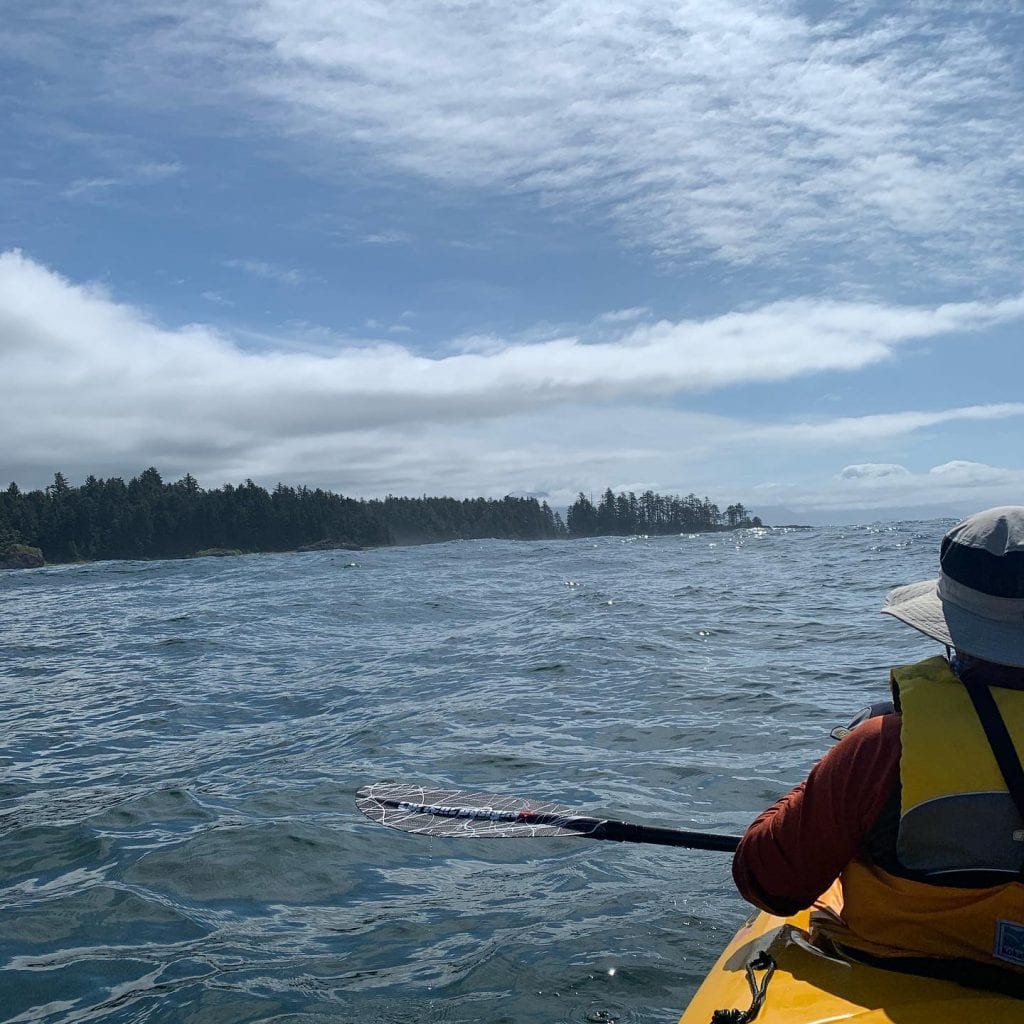
Getting on the water was as exciting as always and as we started off heading North West on the Tofino Flats, a bald eagle dived 3 meters from our kayak, catching a fish.
It promised an exciting trip.
It was surprising as we went along, how much boat traffic there was on the water, despite the times of Covid. No kayaks, no sail boats, but constant motor boats in both directions. It makes one realize that there are quite a few scattered villages inhabited mainly by the people local to this area.
As friend David suggested, the route was protected from the wind and offered very enjoyable paddling for the first 1 hour and 15 minutes. However, as we approached Flores Island, we arrived to the exposed area in direct connection with the ocean. It was about 6:00 p.m. and the head wind was strong. We kept close to the shore but without much protection, largish waves, we were soaking wet within 10 minutes. After approximately 30 minutes we were able to find some protection from the wind by skipping from big rock to big rock making slow but steady head way. While we were enjoying the challenge of wind and waves, we were looking forward to getting to the area protected by Flores Island.
At this point, Stefan spotted a stretch of sandy beach with some protection from the wind with a beautiful west view. We quickly decided this was camp site number one. It was a long deep beach with a little fresh water creek on the side. As we were soaking wet, and the beach did not have total protection from the wind, it took a while to warm up in our dry warm clothes. We had covered 15 km in 2 hours and 45 minutes.

To our surprise, there were quite a few singing birds in the deciduous trees by the beach. Unfortunately, we could not identify them due to our limited knowledge of Ornithology (Stefan says I pay no attention to birds.)
We had our meal, warm tea and were off to sleep. As I was drifting out, Stefan was analyzing the singing patterns of the birds – wondering if this could be a male singing to a female in the nest.
Surprisingly we slept until 7:00 a.m., and had a slow start, getting on the water at 9:00 a.m. A clear day with no wind, we hoped we would be able to make it to Hot Springs Cove. I hadn’t done much map work prior to the trip, but we thought we would have to cover about 30 km, which seemed a bit ambitious.
The beginning went very well, and we were covering good ground. It was not always super evident which route to take despite my Garmin Inreach GPS and Google Maps on my phone. At one point the route narrowed to a channel (Obstruction Island). Before we reached the channel we were helped by the strong current and we reached our maximum pace of thrip … 5.6 km per hour according to my GPS watch. The moment the channel opened into a wider body of water at the northern tip of Flores Island, it visibly ran into an opposed current creating chaotic waves.
At this point, I insisted it was time for a break. Since I was in the stern and controlled the rudder, I made it happen. (Stefan was afraid of the wind picking up, as forecasted, and wanted to cover as much distance as possible, without breaks.) We were able to find a rocky beach with some grass, and many oysters.
We were about 12 km away from Hot Springs Cove when the wind did pick up, resulting in many strong but short waves. We paddled on wards until we were less than 2 km from the desired destination. We were trying to decide if we would cross the channel and go to the cove that evening, or find a beach and camp.
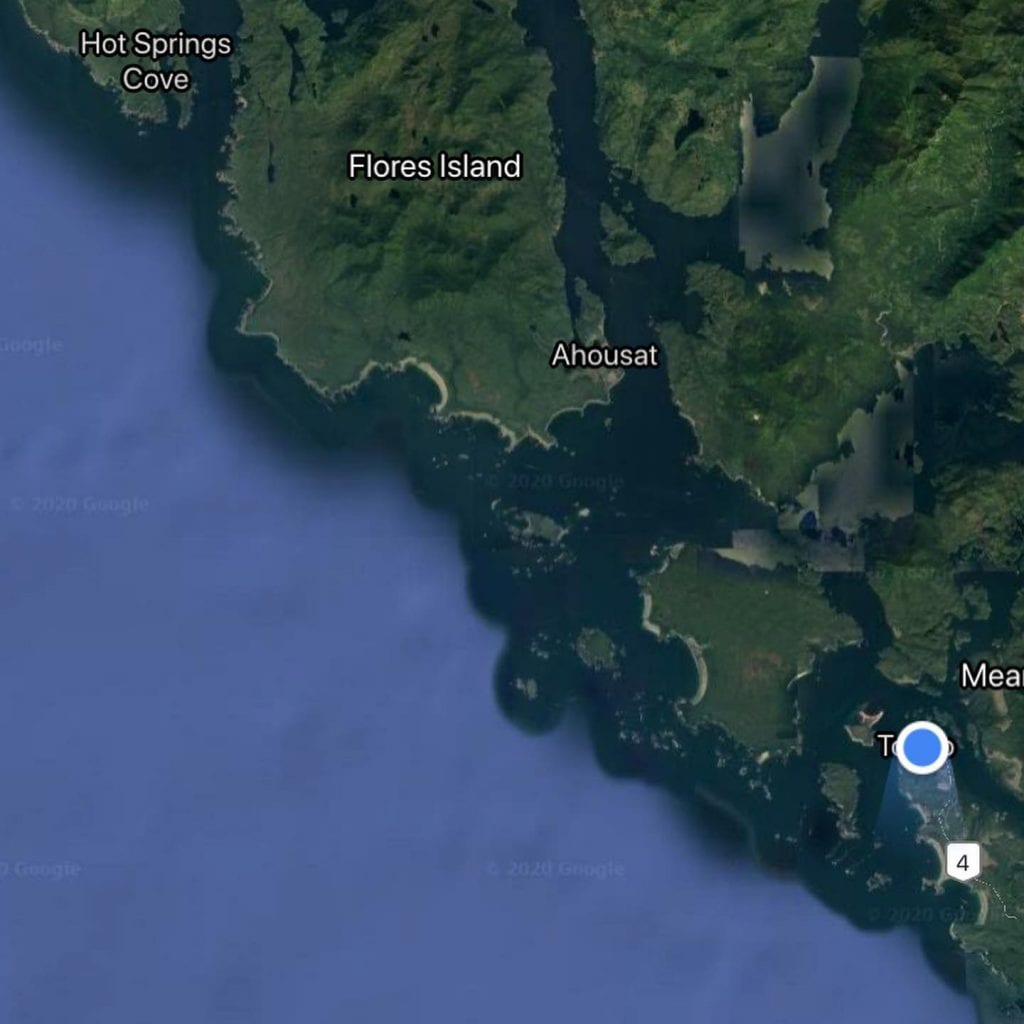
We rested, then paddled on the lee side of an island and spotted a beautiful sandy beach. We thought, that’s definitely a good spot to camp. While the wind was strong, we were uncertain of what the inlet would be like at Hot Springs Cove, as it is exposed on open ocean.
We began paddling from the lee side of the Island into the 36 km per hour wind and waves … and knew immediately we would not be doing the 2 km crossing.
We landed at the previously sighted beautiful beach behind a knoll, where we were protected from the wind. This was camp #2. We had just covered 31 km.
Our biggest decisions this evening, how to prepare our oysters, found on our lunching beach. We had no shucker, my small jet boil cooking stove could hardly hold one of these oysters … so we had a beach fire, throwing the oysters into the coals. The oysters would steam themselves, and open up. Cruel but delicious!
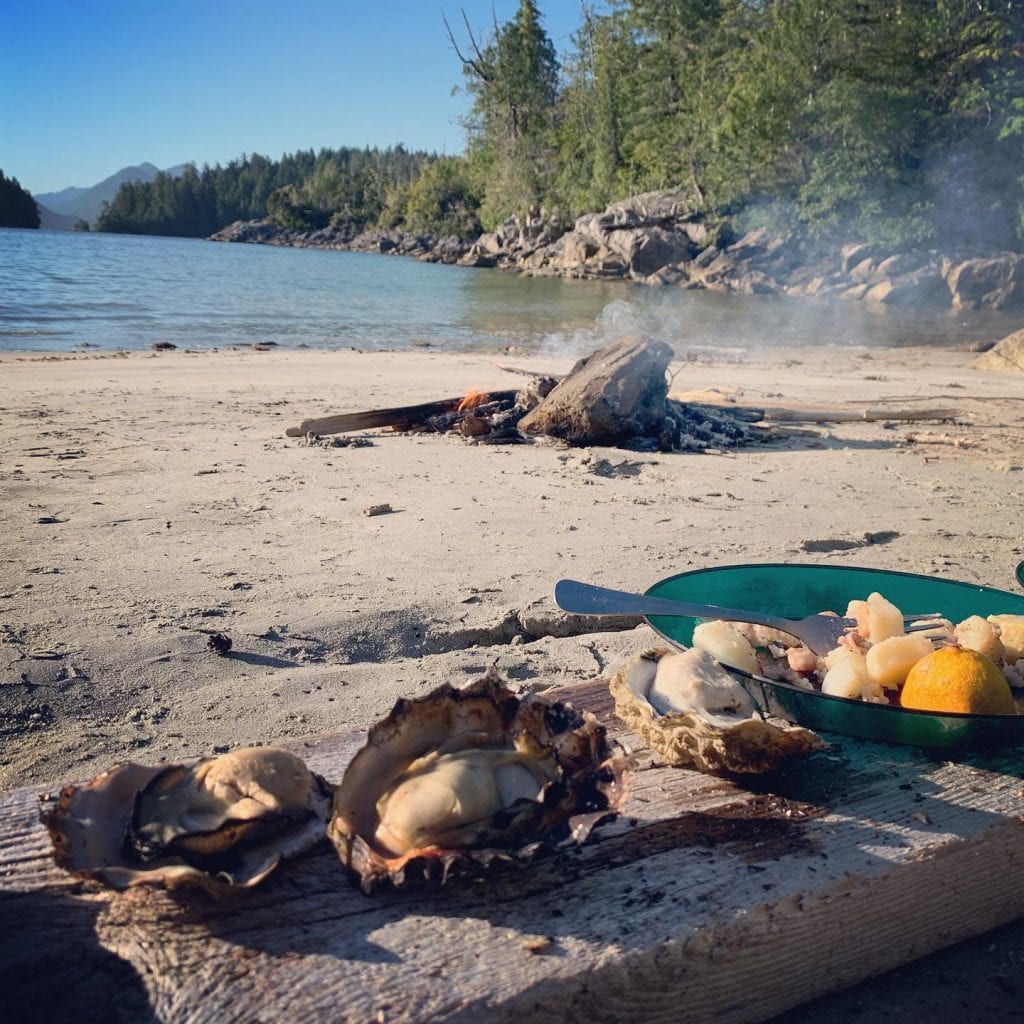
We knew that tomorrow would be a long day, with no wind forecasted until strongish West winds in the late morning. We woke at 5:10 a.m., and were on the water within an hour. With no wind, the crossing was easy. To our disappointment, we ran into a boat where the owner informed us that Hot Springs Cove was closed due to Covid. (We had been warned that likely it would be.)
As a result we were on the open Pacific by 7:30 a.m., heading South along the otter coast of Flores Island. There was clear skies on the west, while the coast was covered in clouds. The clouds would break, giving us occasional sun. There was no wind, and paddling on big ocean swells was exciting.
To our disappointment paddling on the open ocean, was not super easy … likely because of currents that we had little idea which direction were going. At some points, it felt to me, that we were not moving at all. According to my watch, we did many kilometres between 16 and 18 minutes. This pace was discouraging.
It was about this time, Stefan spotted some ‘blows’. We were paddling with the Whales! We spotted at least 6, which we believed were Grey Whales.
According to the forecast, the west wind was supposed to come at 11:00 a.m., but did not show until 2:00 p.m. We were hoping to catch the wind, that would give us a good push on the inland route towards Tofino.
Finally at the Southern West tip of Flores, we have been in the boat for 7-ish hours without getting out. There did not appear to be any easy landing places. Stefan was game to paddle direct to Vargas, seeing there were no desirable places to land, and worried that the wind would pick up as forecasted.
2.5 km away from the presumed Vargas Island, I realized it was not Vargas. Vargas was another 9 km away. While floating in the boat, deciding if we should carry on to Vargas, we spotted a beautiful beach with Eastern Exposure, completely protected from the wind.
We landed and lunched. We had amazing panoramic view with Flores on the North and Vargas on the South. We were on Bartlett Island. In nearly years of quite a lot of sea kayaking, this may have been the longest I’ve ever been in a kayak in one stretch – about 8 hours!
At this point, we face the opportunity to camp an extra night, or paddle on realizing we are still about 16 km to Tofino. This place is one of the most beautiful spaces I’ve ever been too. It was beach, views, water, mountains, green of the trees – incredible.
We paddle on. Do we go on the more interesting and shorter route on the outside of Vargas, or paddle on the inside where it is safer. As we were tired, the wind was unpredictable, Stefan’s shoulder was sore, we made the safer decision to paddle inside Vargas.
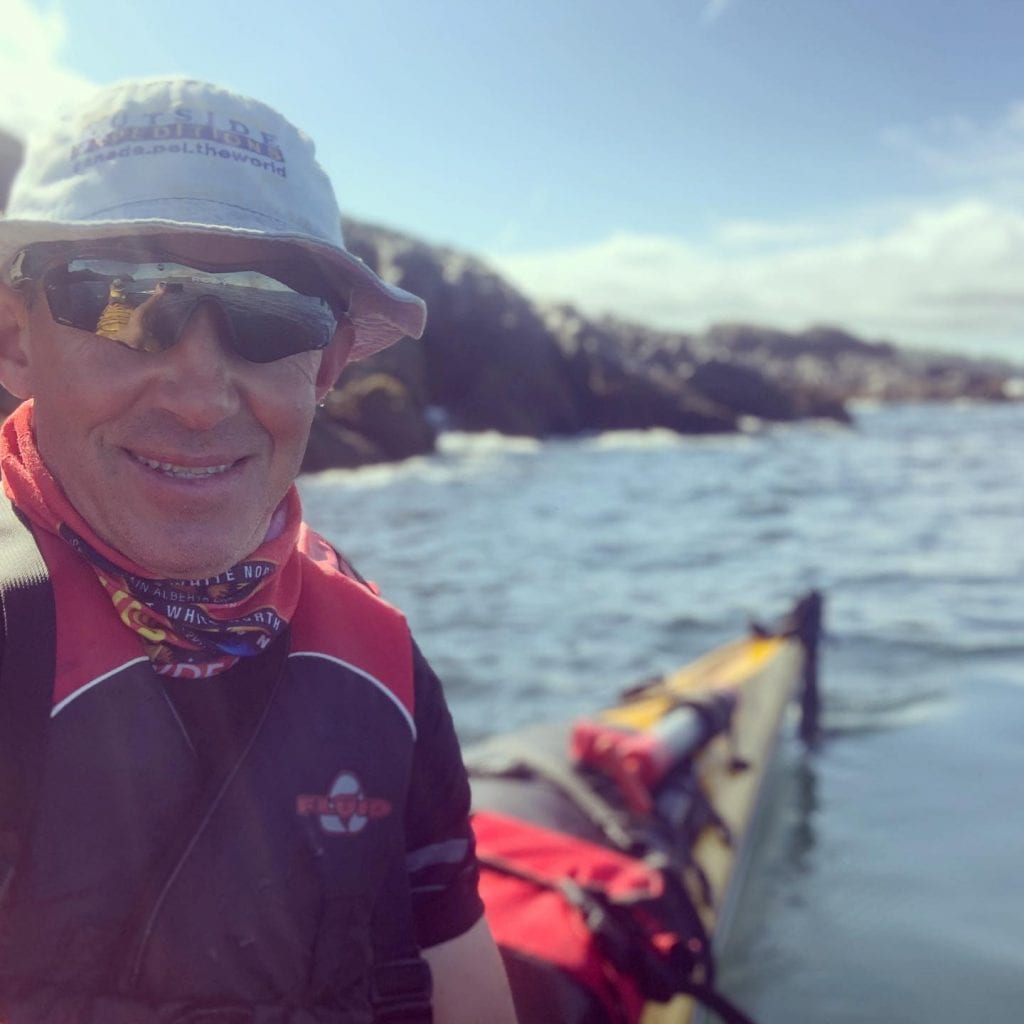
We paddled, and paddled, and paddled some more. We see three other paddlers going in the opposite direction from Tofino … the first fellow kayakers we see. I later learn from Instagram stories that it is my cycling friend Stephen Becker, also from Calgary.
Paddling towards Tofino, we see the sandy beach where wife Shirley and I paddled to and stayed a few nights in 1993. From there it is only a crow fly to the Tofino Public Boat Launch.
45 kilometres and 11 and half hours, we were very pleased to have the energy to pose for a selfie and drive three hours to Denman Island. (We missed the last ferry from Buckley Bay.)
